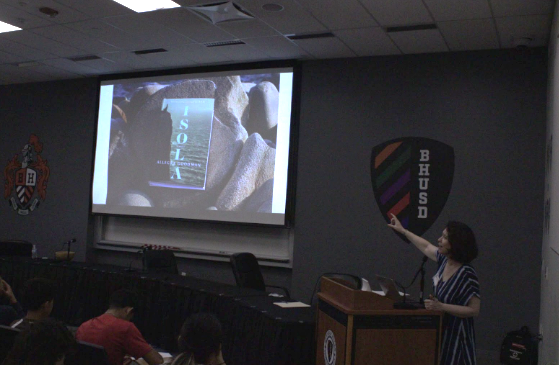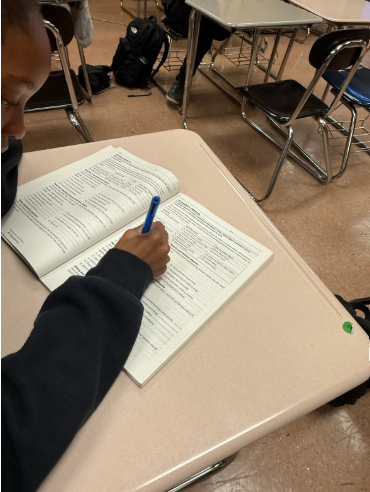Mia Gorlick Watchtower staff member
Some teachers on campus have a policy that allows students who earn a five on the AP exam to have their grades raised to an A. For example, in one AP math class, approximately 25-30% of students receive a grade adjustment at the end of the year. A score of four on the exam can raise a class grade by one letter, and a score of five can raise it by two letter grades. Depending on student citizenship and participation, it is possible that a student’s grade could be raised from a C to an A.
This policy raises some concerns and warrants further exploration, as such a discrepancy indicates that the exams do not always align with, and may in fact take precedence over, class grades and teaching. If AP classes are truly meant to prepare students for the AP exam, class grades and test scores should both be reflective of that dynamic.
AP classes are intended to challenge students and provide them with a college-level academic experience while still in high school. For students pursuing higher education, they can opt to take an AP exam and if they subsequently earn a passing score, it could exempt them from taking the corresponding class later in their academic careers. This, in turn, provides the student with the ability to earn their degree faster and begin taking classes more tailored to their major. Given the rigorous and demanding nature of AP classes, students often take them with the intent of taking and passing the end-of-year AP exam. Therefore, despite technically being optional, these exams have become an integral part of the AP experience, and as such, heavily influence the AP curriculum.
The tests, quizzes, essays, assignments and projects work collectively to give the student a proper foundation upon which they can hone their knowledge and feel well-prepared to pass their exams. The generally-accepted passing range for AP exams is a score of three to five. A score of five on an exam is indicative of a very strong understanding of the material taught throughout the entire school year. Therefore, it is concerning that students who receive a five on their exam are having their class grades raised to an A. If a strong understanding of the material is reflected on the exam, the same should be said of the class grade. This is especially true for students in AP classes that consider an 85% or higher to be an A. Having a B or C in such a class would mean that the student’s grade ranges from the fiftieth-to-eightieth percentile. The notable difference that exists between a low B or C in an AP class and a 5 on an AP exam is indicative of a disconnect.
Additionally, every AP exam includes a large multiple-choice component. This means that many, if not all AP classes, heavily utilize multiple-choice tests, which are objectively graded. Students who pass the objective portion of the cumulative AP exam with flying colors should have objective class assessments that show a similar trend.
When AP classes and exams heavily influence one another, and both include objective components that mitigate the possibility of highly subjective grading, there should not be such a marked difference. Given that such grade adjustments have become actual policies among certain teachers, it is clear that these grade discrepancies are not a one-time occurrence.
However, disconnects between AP test scores and class grades stem from a more systemic issue: only certain classes and teachers utilize such grade adjustment policies. While the aforementioned AP math teacher has a policy in which a five on the exam can raise a grade by two letters, one AP science teacher has openly expressed their strong opposition towards such policies. While one AP history teacher utilizes a similar policy in which a five on the AP exam can raise a student’s class grade to an A, Barbara Nealis, an AP English teacher, claims that she does “not personally have a policy for a grade change due to performance on the AP exam” nor does she “know of any other English department member who has such a policy.” In yet another interview, counselor Kathleen Blanco stated that “this grade change after the AP exam has occurred a few times for [her] students” and that “the numbers aren’t very high.”
This disconnect between different teachers, school officials and subject departments is another source of confusion as these discrepancies disrupt the equality of AP classes. If some AP classes have a rather large percentage of students who receive grade adjustments, whereas other classes do not have a policy in place at all, it is implied that certain exams and teachers are subjectively more difficult than others, an insinuation that makes certain AP classes appear more appealing in the eyes of students.
Such disconnects point to the concerning conclusion that AP grading is not standardized and objective; if teachers are able to decide whether or not to adopt policies that directly influence students’ grades, it appears that AP class grading is highly subjective. A student’s final grade is not merely influenced by their performance in class, but also by their AP exam grade–which, though associated with the class, is not a mandatory component–as well as their teacher’s personal grading preferences and policies.
This convoluted and subjective dynamic reduces the appeal of AP classes as students walk away with a rather disheartening message: that their grade and perceived success in a class is highly dependent on the AP class they choose to pursue and the teacher they are assigned. Based on this, it is clear that a bifurcated structure exists in which there is no standard by which students are given final grades. Given the rigid and objective structure of the AP exam, it is counterintuitive that AP teachers create grading policies separately rather than as a united front.
The importance of the AP exam continues to grow as students attempt to hone their academic portfolios and market themselves as worthy candidates during the college admissions process. As such, AP classes become more heavily influenced by the exams. If this continues to be a reality, changes should be made in order to promote greater grade continuity.
As an education system, we should begin affecting change by speaking to students and asking them what they feel the best course of action may be. If exam and class grade discrepancies appear to be issues that extend beyond the scope of just this school, teachers should work with the CollegeBoard in order to identify possible reasons as to why such grade discrepancies exist. District meetings should be held in order to address the policy discrepancies that exist between different teachers and departments. The key to affecting change, especially in the academic realm that involves students, teachers, organizations, and families, is communication.
After productive discussion, educators may make the micro-level decision to alter teaching strategies so that teachers can best prepare their students for simultaneous success on the AP exam and in the classroom. Perhaps in proactively communicating, change will be affected on a more macro-level and less emphasis will be placed on exam scores, with the bulk of the focus being on learning.
The current AP-preparation model does not benefit students or teachers as students are left with subjectively-determined class grades while teachers are forced to teach to a single exam. It is through an exploration of dynamics such as these that we develop and modernize in order to best prepare future generations for success, and not just on exams. By learning how to identify disconnects and advocate on behalf of positive and timely change, we learn how to equip ourselves for the macro-level world.































